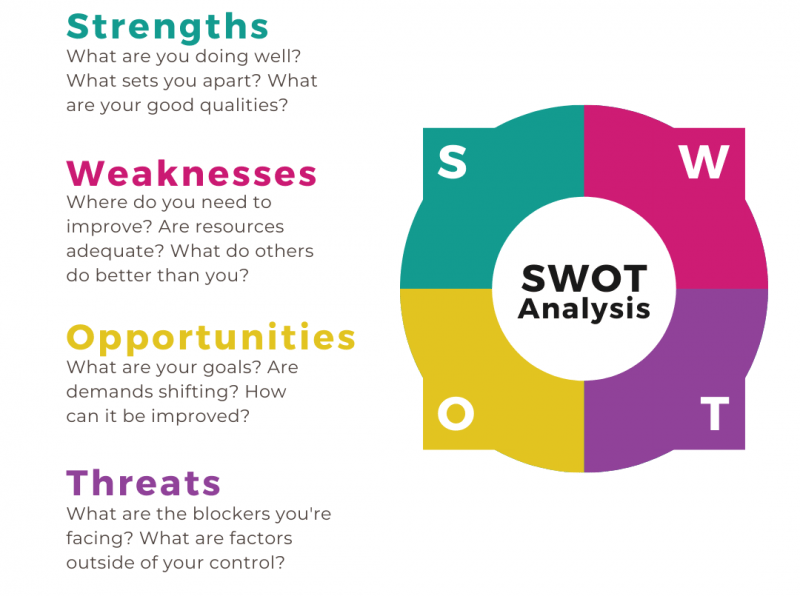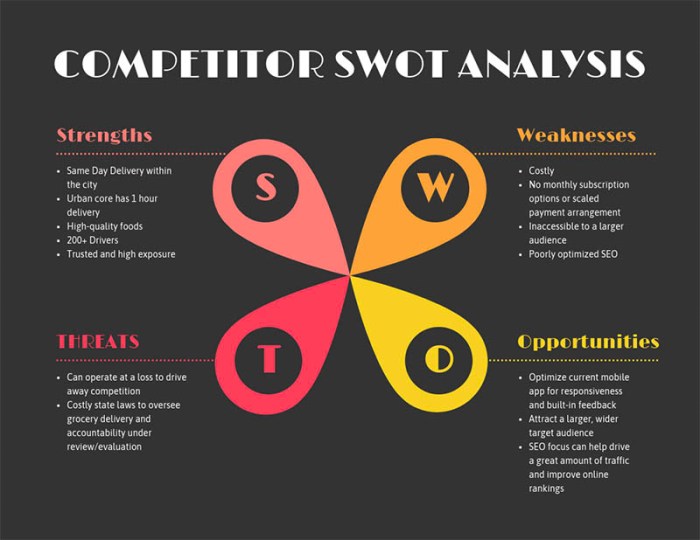Swot analysis example flower shop – SWOT analysis is a powerful tool for flower shops to gain a competitive advantage. By identifying their strengths, weaknesses, opportunities, and threats, flower shops can develop strategies to capitalize on their strengths, mitigate their weaknesses, seize opportunities, and minimize threats.
This guide provides a comprehensive framework for conducting a SWOT analysis for a flower shop. It includes a discussion of the key factors to consider for each element of the SWOT analysis, as well as examples and tables to illustrate the process.
SWOT Analysis for Flower Shop: Swot Analysis Example Flower Shop

SWOT analysis is a strategic planning tool used to evaluate the internal and external factors that affect a business’s performance. It involves identifying the strengths, weaknesses, opportunities, and threats (SWOT) that a company faces. For a flower shop, SWOT analysis can help identify areas where the business can improve and capitalize on opportunities for growth.A
comprehensive SWOT analysis framework includes the following steps:
- Identify internal factors that contribute to the flower shop’s competitive advantage. These strengths can include resources, capabilities, and market position.
- Identify internal factors that hinder the flower shop’s performance. These weaknesses can include operations, financial stability, and customer service.
- Explore external factors that present growth potential for the flower shop. These opportunities can include market trends, new technologies, and partnerships.
- Identify external factors that pose challenges to the flower shop’s success. These threats can include competition, economic conditions, and environmental factors.
Strengths
The strengths of a flower shop can be identified by considering its internal resources, capabilities, and market position. Some common strengths of flower shops include:
Fresh and high-quality flowers
Flower shops that source their flowers directly from growers or have their own greenhouses can offer fresh and high-quality flowers to their customers.
Skilled florists
Experienced and skilled florists can create beautiful and unique arrangements that meet the needs of customers.
Strong brand reputation
Flower shops with a strong brand reputation can attract loyal customers who trust their products and services.
Convenient location
Flower shops located in convenient areas with high foot traffic can attract more customers.
Weaknesses
Weaknesses are internal factors that hinder the performance of a flower shop. Some common weaknesses include:
Limited operating hours
Flower shops that have limited operating hours may miss out on potential customers who prefer to shop during evenings or weekends.
High operating costs
Flower shops have high operating costs due to the perishable nature of their products and the need for skilled labor.
Competition from online retailers
Online retailers offer convenience and a wide selection of flowers, which can pose a threat to traditional flower shops.
Seasonality
Flower sales can fluctuate depending on the season, which can lead to inconsistent revenue streams.
Opportunities, Swot analysis example flower shop
Opportunities are external factors that present growth potential for a flower shop. Some common opportunities include:
Growing demand for floral arrangements
The demand for floral arrangements is growing due to increased spending on special occasions and home décor.
New technologies
New technologies, such as online ordering and mobile payments, can help flower shops reach a wider audience and improve customer convenience.
Partnerships with event planners
Partnerships with event planners can provide flower shops with access to new customers and opportunities for larger orders.
Expansion into new markets
Flower shops can expand into new markets by opening additional locations or offering online delivery services.
Threats
Threats are external factors that pose challenges to the success of a flower shop. Some common threats include:
Competition from mass retailers
Mass retailers, such as grocery stores and home improvement stores, offer a wide selection of flowers at lower prices, which can pose a threat to small flower shops.
Economic conditions
Economic downturns can lead to decreased consumer spending on non-essential items, such as flowers.
Environmental factors
Natural disasters, such as hurricanes and floods, can disrupt flower supply chains and damage flower shops.
Changing consumer preferences
Changing consumer preferences, such as the growing popularity of artificial flowers, can pose a threat to traditional flower shops.
Commonly Asked Questions
What is SWOT analysis?
SWOT analysis is a strategic planning tool that helps organizations identify their strengths, weaknesses, opportunities, and threats. It is a valuable tool for flower shops to gain a competitive advantage.
What are the key factors to consider for each element of the SWOT analysis?
For strengths, consider internal factors that contribute to the flower shop’s competitive advantage, such as resources, capabilities, and market position. For weaknesses, consider internal factors that hinder the flower shop’s performance, such as operations, financial stability, and customer service. For opportunities, consider external factors that present growth potential for the flower shop, such as market trends, new technologies, and partnerships.
For threats, consider external factors that pose challenges to the flower shop’s success, such as competition, economic conditions, and environmental factors.
How can flower shops use SWOT analysis to develop strategies?
Flower shops can use SWOT analysis to develop strategies that will help them capitalize on their strengths, mitigate their weaknesses, seize opportunities, and minimize threats. For example, a flower shop with a strong brand reputation could use this strength to develop a marketing campaign that highlights its unique value proposition.
A flower shop with a weakness in customer service could develop a training program to improve the quality of its service.

